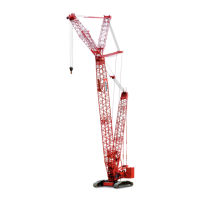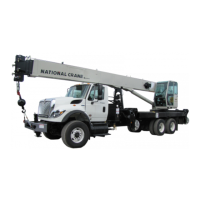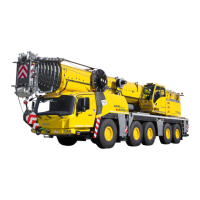The wind’s affect on the rear of the load
increases load radius. This condition can result
in an overload hazard, possibly causing the
crane to tip or the boom to collapse.
To avoid this hazard, reduce operating speeds
and load (see Wind Conditions Chart at the
end of this section or see wind conditions in
Capacity Charts if applicable).
The boom can buckle and
collapse if the load
contacts the boom.
FIGURE 3-52
Forward stability is affected by
wind on the rear of the boom. Wind
applies a force to the boom and
load that adds to the crane’s
overturning moment. This action
has the same effect as adding load
to the hook.
Backward stability is affected by
wind on the front of the boom.
This condition is especially
dangerous when the boom is at or
near the maximum angle when
operating without load.
Wind forces on the front of the
boom reduce the normal forward
tipping effect of the boom. The
crane can tip or the boom can
collapse if this condition is not
avoided.
Boom strength is affected
the most when the wind acts
on the side of the boom.
The wind’s affect on the side
of the load can cause the
load to swing out past the
boom hinge pin. This
condition can result in
excessive side load forces
on the boom, possibly
causing the crane to tip or
the boom to collapse.
To avoid this hazard, reduce
operating speeds and load
(see Wind Conditions Chart
at the end of this section or
see wind conditions in
Capacity Charts if
applicable).
3-128
3-129
3-127













